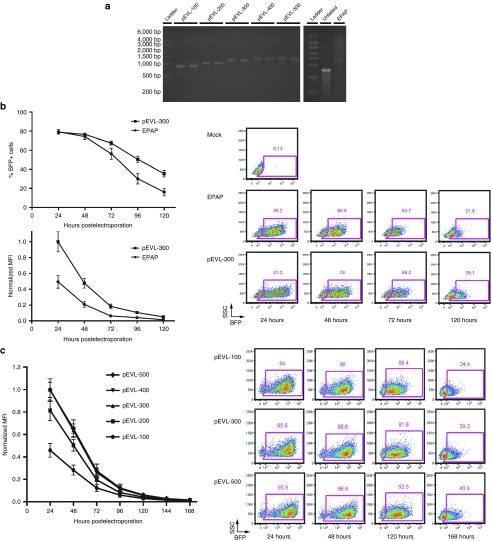Figure 4.
Generation and characterization of mRNA from pEVL-encoded templates. (a) IVT mRNA encoding blue fluorescent protein (mTagBFP2) generated from pWNY with enzymatic tailing and pEVL-100 through pEVL-500. BFP-pEVL-100 to 500 were digested with XbaI and BsaI, and pWNY with ScaI and BsiWI, to generate template for IVT. IVT was carried out with antireverse cap analog capping, and for pWNY, enzymatic tailing with EPAP. After purification, 200 ng of each transcript was imaged via gel electrophoresis on the FlashGel system. Typically, pEVL produces a single band of defined length, whereas pWNY with enzymatic tailing produces transcripts of a more heterogenous length. (b) Relative potency of mRNA encoding BFP generated from a circular plasmid vector with enzymatic polyadenylation or from pEVL-300 and representative flow plots. 1 μg of IVT mRNA from the indicated template was electroporated into prestimulated primary human T cells. After a 24-hour cold shock at 30 °C, the cells were analyzed each day for 5 days by flow cytometry for the percentage of cells expressing BFP as well as the mean fluorescence intensity (MFI) of the BFP in BFP+ cells. Flow plots are shown as side scatter (SSC) versus BFP. (c) Relative potency of mRNA encoding BFP generated from pEVL-100 through pEVL-500 and representative flow plots. Equimolar amounts of IVT mRNA from BFP-pEVL-100 to 500 were electroporated into prestimulated primary human T cells. After an initial 24-hour cold shock at 30 °C, the cells were grown at 37 °C for 6 more days. Every 24 hours after electroporation, the percentage of cells expressing BFP and the BFI MFI of the BFP+ cells was analyzed by flow cytometry. Flow plots are shown as side scatter (SSC) versus BFP. BFP, blue fluorescent protein; IVT, in vitro transcribed; pEVL, p(Extended Variable Length).

